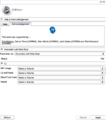Difference between revisions of "2012 Summer Project Week:UtahInhomogeneity"
| Line 34: | Line 34: | ||
<h3>Progress</h3> | <h3>Progress</h3> | ||
| − | Software for the inhomogeneity correction has been implemented [http://wiki.na-mic.org/Wiki/index.php/DBP3:Utah:SlicerModuleInhomogeneity]. We | + | Software for the inhomogeneity correction has been implemented [http://wiki.na-mic.org/Wiki/index.php/DBP3:Utah:SlicerModuleInhomogeneity]. We have created documentation/tutorial for the module. Lastly, we have updated the acknowledgements section to include the appropriate logos and information. The module is now available as a loadable extension in Slicer 4. |
Latest revision as of 20:07, 21 June 2012
Home < 2012 Summer Project Week:UtahInhomogeneityKey Investigators
- Utah: Danny Perry, Alan Morris, Josh Cates, Eugene Kholmovski, Rob MacLeod
Objective
We are developing methods for localized inhomogeneity correction for cardiac LGE-MRI images. The goal is to be able to reduce some of the noise inherent in cardiac LGE-MRI scans to improve clinical diagnoses and statistical comparisons.
Approach, Plan
Our approach for inhomogeneity correction is a gradient function to the image data that normalizes accordingly.
Our plan for the project week is to test our module, and ensure that it meets "Ron's Rules" and develop supporting documentation/examples.
Progress
Software for the inhomogeneity correction has been implemented [1]. We have created documentation/tutorial for the module. Lastly, we have updated the acknowledgements section to include the appropriate logos and information. The module is now available as a loadable extension in Slicer 4.
Delivery Mechanism
This work will be delivered to the NA-MIC Kit as a
- ITK Module - NO
- Slicer Module
- Built-in - NO
- Extension -- commandline - YES
- Extension -- loadable - NO
- Other (Please specify)


